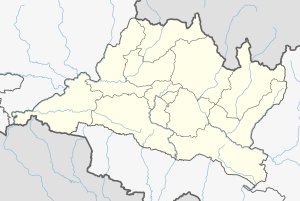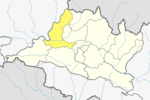|
Tripurasundari Rural Municipality, Dhading
Tripurasundari is a rural municipality located within the Dhading District of the Bagmati Province of Nepal. The rural municipality spans 271.23 square kilometres (104.72 sq mi), with a total population of 22,960 according to a 2011 Nepal census.[1][2] On March 10, 2017, the Government of Nepal restructured the local level bodies into 753 new local level structures.[3][4] The previous Salyantar, Mulpani, Salyankot, Aginchok and Tripureshwar VDCs were merged to form Tripurasundari. Tripurasundari is divided into 7 wards, with Salyantar declared the administrative center of the rural municipality. DemographicsAt the time of the 2011 Nepal census, Tripurasundari Rural Municipality had a population of 22,992. Of these, 95.2% spoke Nepali, 1.3% Tamang, 1.2% Kumhali, 0.6% Ghale, 0.6% Gurung, 0.5% Newar, 0.1% Bhojpuri, 0.1% Hindi, 0.1% Magar, 0.1% Urdu and 0.1% other languages as their first language.[5] In terms of ethnicity/caste, 26.5% were Chhetri, 13.2% Hill Brahmin, 12.2% Magar, 9.9% Newar, 9.8% Kumal, 6.3% Sarki, 4.2% Kami, 3.6% Damai/Dholi, 3.5% Darai, 3.1% Sanyasi/Dasnami, 2.5% Thakuri, 2.0% Gurung, 1.5% Tamang, 0.8% Ghale, 0.3% Musalman, 0.2% Majhi, 0.1% Rai, 0.1% Terai Brahmin and 0.3% others.[6] In terms of religion, 96.5% were Hindu, 1.6% Christian, 1.4% Buddhist, 0.3% Muslim and 0.2% others.[7] In terms of literacy, 64.0% could both read and write, 2.6% could read but not write and 33.4% could neither read nor write.[8] References
External links
|
||||||||||||||||||||||||||||||||||||||||


